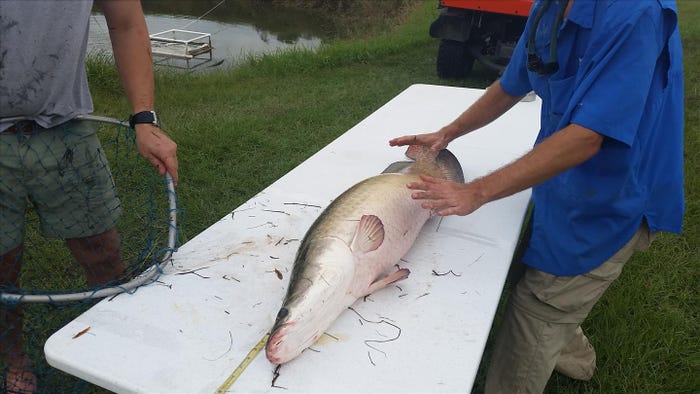Risk analysis shows Arapaima could be raised in Florida fish farms.
January 5, 2016

Arapaima is a fish eaten regularly in South America, and University of Florida Institute of Food & Agricultural Sciences (IFAS) researchers are studying whether it could be a viable food fish in the U.S.
"It has lots of high-quality meat," said Jeffrey Hill, IFAS associate professor of fisheries and aquatic sciences. "It's an easy fish to sell. It's a really good food fish. It's one of my favorites. It's has a good taste. It's easy to cook."
Hill, doctoral student Katelyn Lawson and other researchers at the IFAS Tropical Aquaculture Laboratory in Ruskin, Fla., recently published two studies concerning Arapaima.

UF/IFAS scientists are studying whether the Arapaima, a popular food fish in South America, can be farmed successfully in Florida. (Credit UF/IFAS)
One study, published in the North American Journal of Aquaculture, found that the fish can only survive in waters that are at least 16°C, or about 61°F. That means it would only survive in south Florida waters, Hill said.
The other study found a low risk of Arapaima getting out of fish farms and into canals. If Arapaima wound up in canals, they would prey on other fish. The risk analysis was published in the North American Journal of Fisheries Management.
"Arapaima is popular as a food fishery species in South America, where it is native," said Hill. "Other markets for the meat include the U.S., Europe and Japan. There's lots of interest in raising them in Southeast Asia, Brazil and at least one farm so far in Florida."
However, more Florida fish farmers may start growing Arapaima, Hill said. Additionally, IFAS maintains Arapaima at two facilities for research.
Also known as Paiche and Pirarucu, Arapaima can grow to more than 200 lb. in the shallow, muddy waters of the Amazon River. The largest freshwater fish in South America, Arapaima has been overfished in Brazil to the point where fisheries in some regions have closed. Restrictions were placed on other Arapaima fisheries in Brazil, but South Americans still fish for Arapaima in Brazil, Guyana, Bolivia and Peru.
"Potentially, there is interest in other states, but the limited cold tolerance of Arapaima prevents them from being grown outdoors during cooler months, which, in turn, increases production costs," Hill said. "If production proves successful, then other farms would add the species, and additional farms would open with Arapaima as the main or an important component of production. Food fish are really hard to raise economically in Florida compared to other aquaculture. A fish farmer could actually make money doing this."
You May Also Like


.png?width=300&auto=webp&quality=80&disable=upscale)
